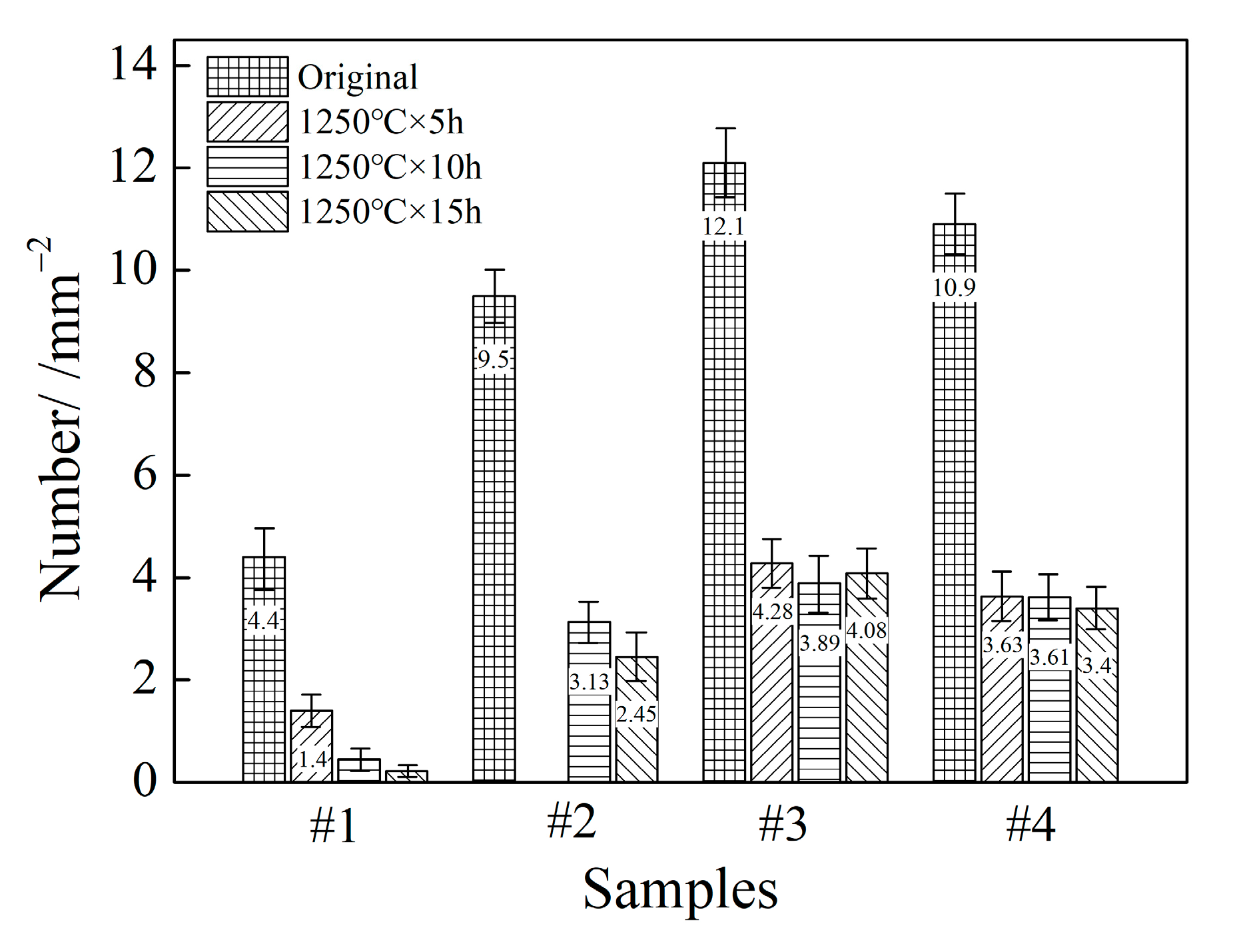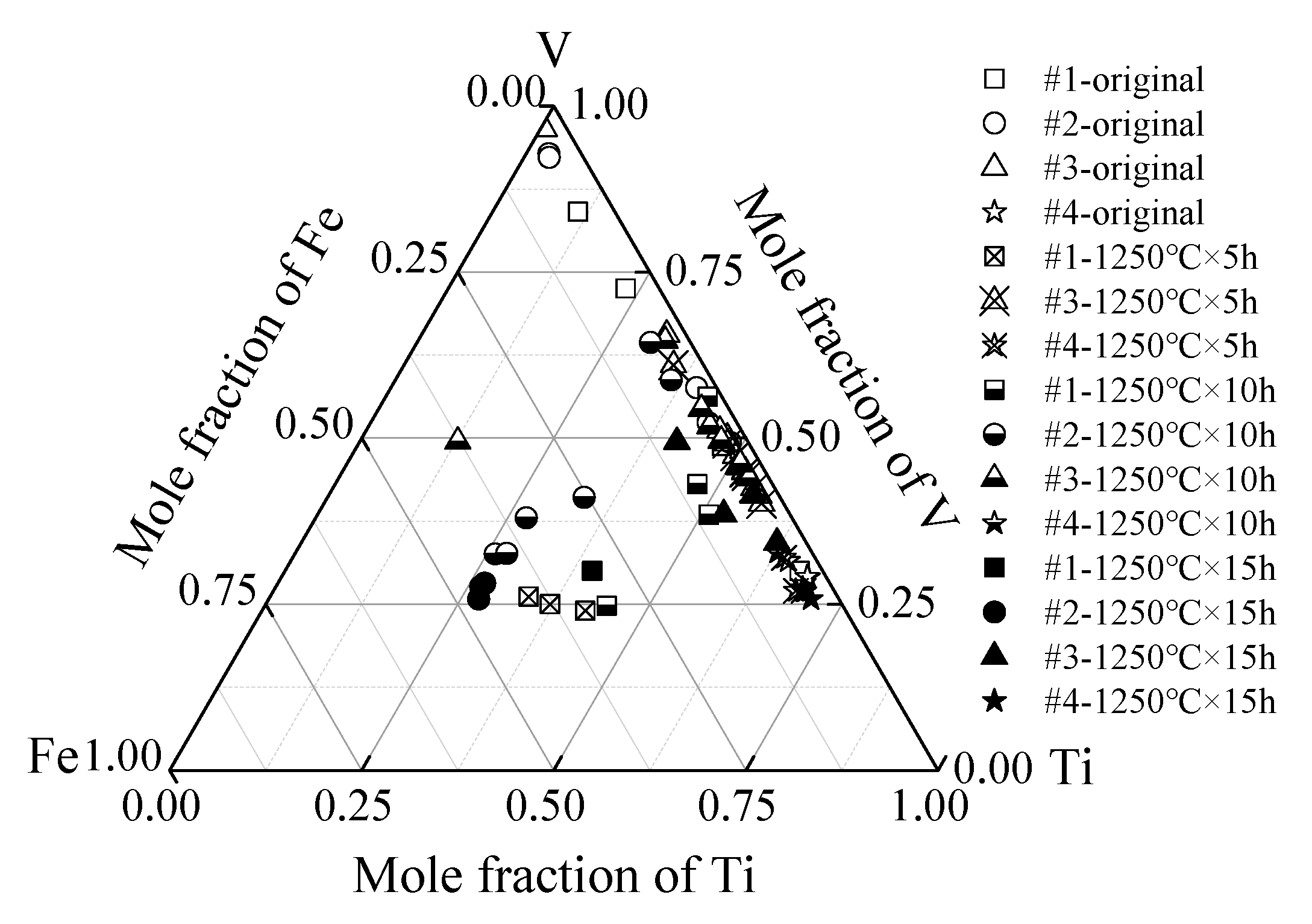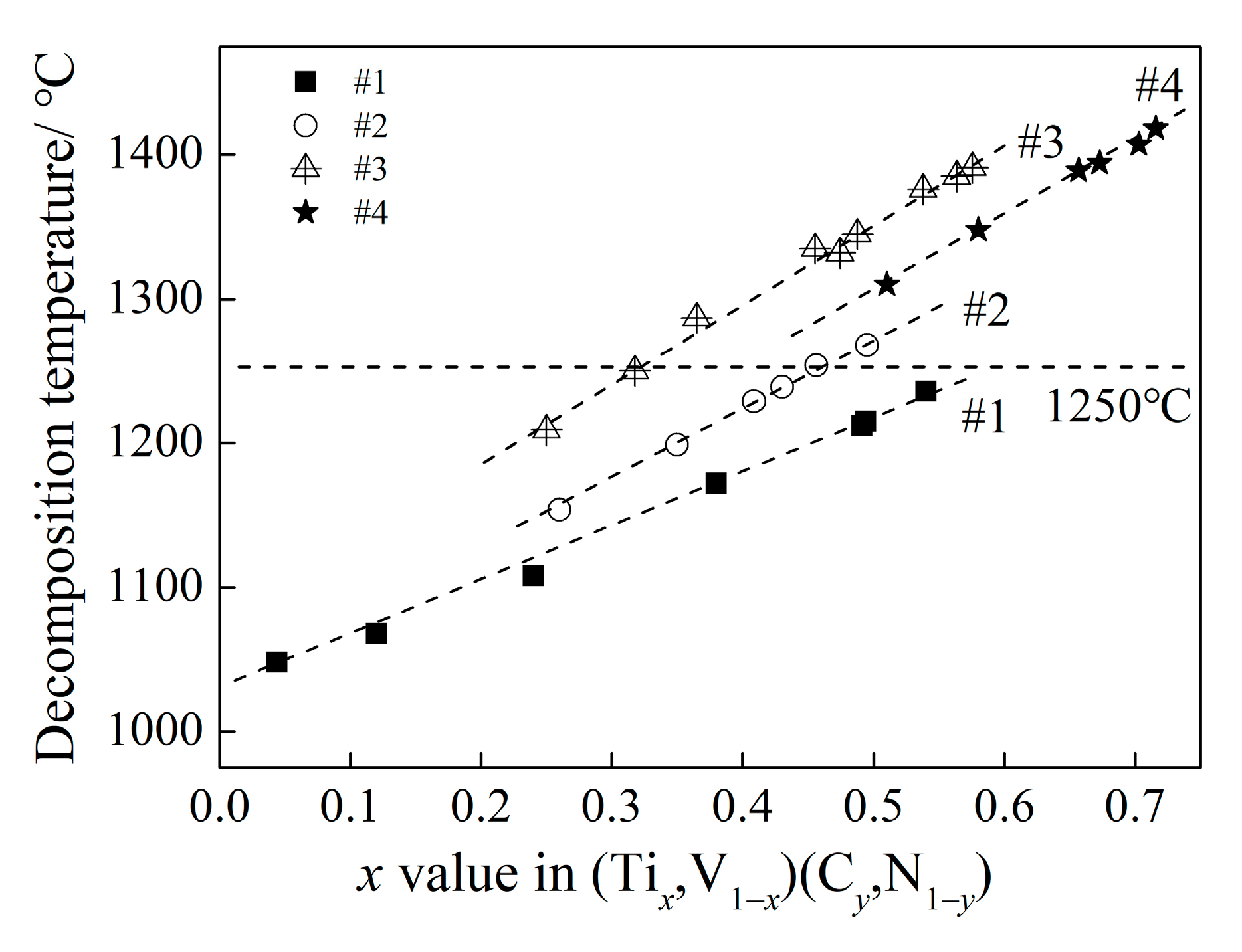Effects of Ti and N Contents on the Characteristic Evolution and Thermal Stability of MC Carbonitrides Holding at 1250 °C in H13 Die Steel
Abstract
1. Introduction
2. Materials and Methods
3. Results
3.1. Morphology Evolution of Carbonitrides during Holding at 1250 °C
3.2. Change in Quantities of Carbonitrides during Holding at 1250 °C
3.3. Changes in Size of Carbonitrides during Holding at 1250 °C
3.4. Change in Composition of Carbonitrides during Holding at 1250 °C
4. Discussion
4.1. Difference in Carbonitride Composition Holding at 1250 °C
4.2. Effect of Ti and N on Thermal Stability of Ti-Containing MC Carbonitrides
4.3. Effects of Ti and N Contents on the Characteristic Evolution of Carbonitrides Holding at 1250 °C
5. Conclusions
- The quantities of carbonitrides decreased by 95%, 74%, 66%, and 69% after holding for 15 h at 1250 °C in the four samples, and the mean sizes decreased to 6.5 μm, 9.3 μm, 6.1 μm, and 10.6 μm, respectively. The addition of Ti resulted in an increase in size and quantity in carbonitrides during holding at 1250 °C while the high N content in sample #3 increased the quantities but decreased the sizes of carbonitrides. It was beneficial for the carbonitrides to decompose in samples #1 and #2 with low Ti and N contents. The product of Ti and N was proportional to the number fraction of the undecomposed carbonitrides held for 15 h.
- After holding at 1250 °C, only the Ti-containing MC-type carbonitrides, (Tix,V1−x)(Cy,N1−y), remained and progressively evolved into the fishnet structure from the compacted block, and this was accompanied with the edges being jagged and granulated with small particles. Results showed that the Fe content in the Ti-containing MC carbonitrides had increased while the Ti content had decreased during the decomposition. It was deemed that the xFe value being larger than 0.25 in the carbonitrides in samples #1 and #2 was beneficial for the Ti-containing MC carbonitrides to decompose when held at 1250 °C compared with xFe being generally smaller than 0.05 in samples #3 and #4.
- On the basis of thermodynamic analysis, the increase in the x value in (Tix,V1−x)(Cy,N1−y) and the decomposed temperature of (Tix,V1−x)(Cy,N1−y) in samples #3 and #4 were ascribed to the increases in Ti and N contents. As a result, the decreases in both sizes and quantities of carbonitrides in samples #3 and #4 were not effective when these samples were held for more than 10 h at 1250 °C. To control MC carbonitrides, a high holding temperature is much more preferable than a long holding time, in addition to having both low Ti and N contents in steel.
Author Contributions
Funding
Data Availability Statement
Acknowledgments
Conflicts of Interest
References
- Oliveira, A.; Lima, L.; Felipe, B.; Bolfarini, C.; Coelho, R.; Gargarella, P. Effect of microstructure and defect formation on the bending properties of additive manufactured H13 tool steel. J. Mater. Res. Technol. 2021, 15, 3598–3609. [Google Scholar] [CrossRef]
- Sun, X.; Guo, H.; Song, G.; Xu, D.; Wang, F.; Zhang, J. Effect of Ti content on the characteristics of MC-type primary carbonitrides in H13 steel. Metall. Mater. Trans. B 2022, 53, 895–901. [Google Scholar] [CrossRef]
- Xie, Y.; Cheng, G.; Chen, L.; Zhang, Y.; Yan, Q. Generating mechanism of large heterogeneous carbonitrides with multiple layers in H13+Nb bar. Steel Res. Int. 2017, 88, 1600119. [Google Scholar] [CrossRef]
- He, B.; Li, J.; Shi, C.; Wang, H. Effect of Mg addition on carbides in H13 steel during electroslag remelting process. Metall. Res. Technol. 2018, 115, 501. [Google Scholar] [CrossRef]
- Huang, Y.; Cheng, G.; Li, S.; Dai, W. Distribution characteristics and thermal stability of primary carbide in cast Ce-H13 steel. ISIJ Int. 2020, 60, 267–275. [Google Scholar] [CrossRef]
- Chen, R.; Wang, Z.; Qi, L.; Zhong, L.; Guan, R.; He, J.; Hu, X. The carbides, tensile properties, and work-hardening behavior of annealed H13 die steels with varied yttrium contents. Mater. Sci. Eng. A 2021, 806, 140856. [Google Scholar] [CrossRef]
- Wang, X.; Li, G.; Liu, Y.; Wang, F.; Wang, Q. Cerium addition effect on modification of inclusions, primary carbides and microstructure refinement of H13 die steel. ISIJ Int. 2021, 61, 1850–1859. [Google Scholar] [CrossRef]
- Ma, C.; Xia, Z.; Guo, Y.; Liu, W.; Zhao, X.; Li, Q.; Qi, W.; Zhong, Y. Carbides refinement and mechanical properties improvement of H13 die steel by magnetic—Controlled electroslag remelting. J. Mater. Res. Technol. 2022, 19, 3272–3286. [Google Scholar] [CrossRef]
- Wang, X.; Li, G.; Liu, Y.; Cao, Y.; Wang, F.; Wang, Q. Investigation of primary carbides in a commercial sized electroslag remelting ingot of H13 steel. Metals 2019, 9, 1247. [Google Scholar] [CrossRef]
- Huang, Y.; Cheng, G.; Zhu, M. Effect of Ti content on the behavior of primary carbides in H13 ingots. Metals 2020, 10, 837. [Google Scholar] [CrossRef]
- Ji, F.; Xu, R.; Gao, Y.; Tian, Q.; Wang, L.; Xiao, Z.; Yin, F. Effect of Ti and rare earth on microsegregation and large-sized precipitates of H13 steel. J. Iron Steel Res. Int. 2021, 28, 1591–1604. [Google Scholar] [CrossRef]
- Tomita, Y.; Saito, N.; Tsuzuki, T.; Tokunagai, Y.; Okamoto, K. Improvement in HAZ toughness of steel by TiN-MnS addition. ISIJ Int. 1994, 34, 829–835. [Google Scholar] [CrossRef]
- Lee, M.; Park, J. Synergistic effect of nitrogen and refractory material on TiN formation and equiaxed grain structure of ferritic stainless steel. Metall. Mater. Trans. B 2018, 49, 877–893. [Google Scholar] [CrossRef]
- Li, L.; Wu, X. Effect of carbides on the thermal stability of Cr3 and Cr5 die-casting die steels. J. Mater. Eng. Perform. 2023, 32, 4483–4499. [Google Scholar] [CrossRef]
- Korade, D.; Ramana, K.; Jagtap, K. Effect of carbide density on fatigue limit of H21 die steel. J. Mater. Eng. Perform. 2020, 29, 230–241. [Google Scholar] [CrossRef]
- Zhu, J.; Lin, G.; Zhang, Z.; Xie, J. The martensitic crystallography and strengthening mechanisms of ultra-high strength rare earth H13 steel. Mater. Sci. Eng. A 2020, 797, 140139. [Google Scholar] [CrossRef]
- Zhang, J.; Tang, M.; Yue, J.; Guo, H.; Li, J.; Bu, H.; Li, M.; Li, S. A Novel heat treatment strategy based on quenching and carbides preprecipitation and subsequent critical quenching to improve the thermal fatigue performance of AISI H13 tool steel. Steel Res. Int. 2023, 94, 220083. [Google Scholar] [CrossRef]
- Shinde, T. Influence of carbide particle size on the wear performance of cryogenically treated H13 die steel. Surf. Eng. 2021, 37, 1206–1214. [Google Scholar] [CrossRef]
- Wang, M.; Ma, D.; Liu, Z.; Zhou, J.; Chi, H.; Dai, J. Effect of Nb on segregation, primary carbides and toughness of H13 steel. Acta. Metall. Sin. 2014, 50, 285–293. (In Chinese) [Google Scholar]
- Park, J.; Ajmal, M.; Priestner, R. Tensile properties of simulated thin slab cast and direct rolled low-carbon steel microalloyed with Nb, V and Ti. ISIJ Int. 2000, 40, 380–385. [Google Scholar] [CrossRef]
- Sun, X.; Wang, F.; Chen, X.; Mao, M.; Guo, H. Study on decomposition of primary carbonitrides in H13 steel under high temperature. Chin. J. Eng. 2017, 39, 721–730. (In Chinese) [Google Scholar]
- Han, Y.; Li, C.; He, S.; Gao, C.; Chen, S.; Li, E. Effect of Homogenisation temperature on the microstructure and microhardness of as-cast H13 steel. Met. Mater. Int. 2021, 28, 755–769. [Google Scholar] [CrossRef]
- Li, J.; Li, J.; Wang, L.; Li, L. Study on carbide in forged and annealed H13 hot work die steel. High Temp. Mater. Process. 2015, 34, 593–598. [Google Scholar] [CrossRef]
- Huang, Y.; Cheng, G.; Li, S.; Dai, W. Precipitation mechanism and thermal stability of primary carbide in Ce microalloyed H13 steel. Acta Metall. Sin. 2019, 52, 1487–1494. (In Chinese) [Google Scholar]
- Han, Y.; Li, C.; Ren, J.; Qiu, C.; Zhang, Y.; Wang, J. Dendrite segregation changes in high temperature homogenization process of as-cast H13 steel. ISIJ Int. 2019, 59, 1893–1900. [Google Scholar] [CrossRef]
- Xie, Y.; Cheng, G.; Meng, X.; Huang, Y. Thermal stability of primary elongated V-rich carbonitrides in H13 tool steel. Metall. Res. Technol. 2017, 114, 206. [Google Scholar] [CrossRef]
- Li, L.; Cai, Z.; Wu, X. Effect of silicon on thermal stability of 4Cr3Mo2V hot-work die steel. Metals 2023, 13, 100. [Google Scholar] [CrossRef]
- Sun, W.; Qin, X.; Guo, J.; Lou, L.; Zhou, L. Thermal stability of primary MC carbide and its influence on the performance of cast Ni-base superalloys. Mater. Des. 2015, 69, 81–88. [Google Scholar] [CrossRef]
- Sun, X.; Guo, H.; Guo, J.; Wang, F.; Xu, D.; Song, G.; Wang, S. Characteristics and stability of oxide + carbonitride in H13 steel at 1250 °C. J. Iron Steel Res. Int. 2024, 31, 134–142. [Google Scholar] [CrossRef]
- Li, J.; Chen, Y.; Huo, J. Mechanism of improvement on strength and toughness of H13 die steel by nitrogen. Mater. Sci. Eng. A 2015, 640, 16–23. [Google Scholar] [CrossRef]
- Wang, H.; Li, H.; Feng, H.; Jiao, W.; Zhu, H.; Zhang, S.; Jiang, Z. A novel high nitrogen hot-work die steel 3Cr5Mo2SiVN achieving excellent hardness-strength-toughness balance. Mater. Charact. 2023, 203, 113154. [Google Scholar] [CrossRef]












| Samples | C | Si | Mn | P | Cr | Mo | V | Ti | N | Fe |
|---|---|---|---|---|---|---|---|---|---|---|
| #1 | 0.40 | 0.93 | 0.38 | 0.012 | 5.17 | 1.55 | 1.04 | 0.0024 | 0.0107 | Bal. |
| #2 | 0.38 | 0.95 | 0.36 | 0.010 | 5.37 | 1.47 | 1.05 | 0.0047 | 0.0143 | Bal. |
| #3 | 0.36 | 0.87 | 0.38 | 0.013 | 5.22 | 1.59 | 1.07 | 0.0049 | 0.0363 | Bal. |
| #4 | 0.41 | 0.95 | 0.37 | 0.011 | 5.07 | 1.51 | 1.03 | 0.0127 | 0.0118 | Bal. |
Disclaimer/Publisher’s Note: The statements, opinions and data contained in all publications are solely those of the individual author(s) and contributor(s) and not of MDPI and/or the editor(s). MDPI and/or the editor(s) disclaim responsibility for any injury to people or property resulting from any ideas, methods, instructions or products referred to in the content. |
© 2024 by the authors. Licensee MDPI, Basel, Switzerland. This article is an open access article distributed under the terms and conditions of the Creative Commons Attribution (CC BY) license (https://creativecommons.org/licenses/by/4.0/).
Share and Cite
Sun, X.; Gao, S.; Shang, W.; Zhong, Q.; Song, G.; Zhao, S. Effects of Ti and N Contents on the Characteristic Evolution and Thermal Stability of MC Carbonitrides Holding at 1250 °C in H13 Die Steel. Metals 2024, 14, 317. https://doi.org/10.3390/met14030317
Sun X, Gao S, Shang W, Zhong Q, Song G, Zhao S. Effects of Ti and N Contents on the Characteristic Evolution and Thermal Stability of MC Carbonitrides Holding at 1250 °C in H13 Die Steel. Metals. 2024; 14(3):317. https://doi.org/10.3390/met14030317
Chicago/Turabian StyleSun, Xiaolin, Shengyong Gao, Wulin Shang, Qingyuan Zhong, Gaoyang Song, and Shuo Zhao. 2024. "Effects of Ti and N Contents on the Characteristic Evolution and Thermal Stability of MC Carbonitrides Holding at 1250 °C in H13 Die Steel" Metals 14, no. 3: 317. https://doi.org/10.3390/met14030317
APA StyleSun, X., Gao, S., Shang, W., Zhong, Q., Song, G., & Zhao, S. (2024). Effects of Ti and N Contents on the Characteristic Evolution and Thermal Stability of MC Carbonitrides Holding at 1250 °C in H13 Die Steel. Metals, 14(3), 317. https://doi.org/10.3390/met14030317





